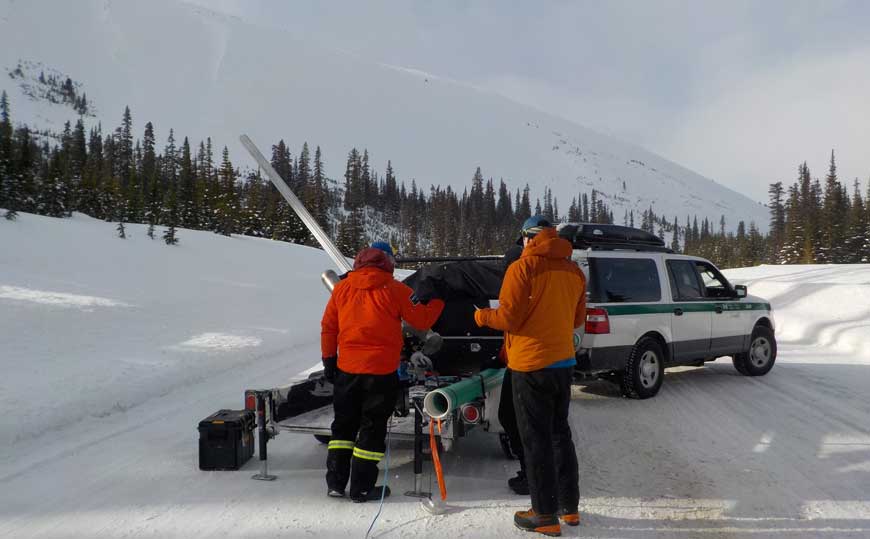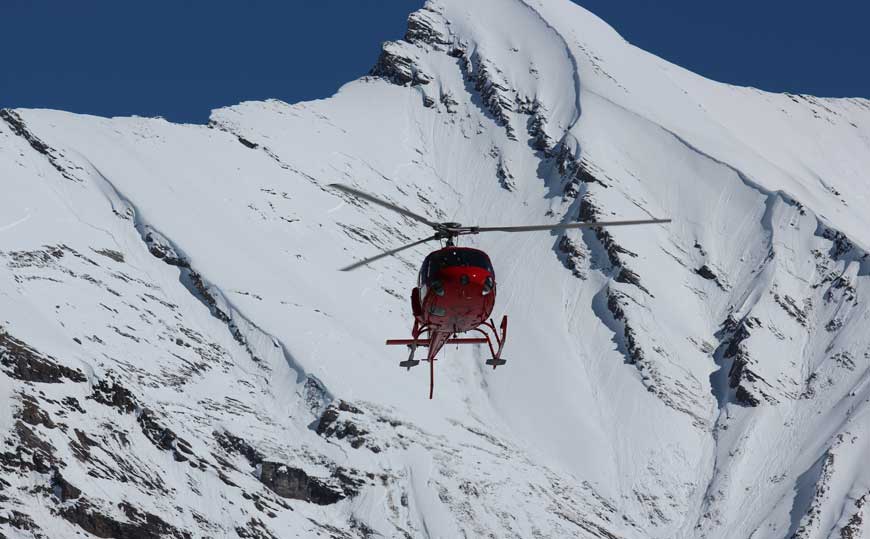
Winter maintenance on the Icefields Parkway
Jasper National Park
The Icefields Parkway (93 North) is world-famous for good reason. From end to end it is brimming with beautiful stops and rugged views. The Icefields Parkway is classified as a scenic parkway, operated and maintained by Parks Canada. The road is designed for Canadians and visitors to experience the majestic beauty and rugged terrain along the continental divide. To preserve the attraction and scenic nature of the parkway, commercial vehicles over 4550 kg are not allowed.
The Icefields Parkway is not managed the same way as travel routes like Highway 1 (The Trans-Canada Highway) or Highway 16 (The Trans-Canada Yellowhead Highway) that carry traffic between provinces.
Learn how you can be prepared to have a great experience on the Icefields Parkway in winter.
Winter maintenance
Is the Icefields Parkway salted?
Like all roads in Jasper, the Icefields Parkway is sanded and salted. We use a sand mix with a lower salt content to limit the attraction for wildlife. This keeps wildlife and drivers safe.
The Icefields Parkway is a scenic parkway. It is not a major through highway like Highways 1 (Trans-Canada) or 16 (Trans-Canada Yellowhead). The use of the Parkway as an alternative to the Trans-Canada Highway system is not recommended in winter. Large commercial vehicles are restricted on the Icefields Parkway.
Snow clearing on the Icefields Parkway occurs between 7 am and 3:30 pm
When needed, Parks Canada snowplows operate between 7 am and 3:30 pm, 7 days a week. Parks Canada recommends travelling the Icefields Parkway during the day. Take advantage of the daylight to see the amazing views which make this road world famous.
The latest road conditions are on Alberta 511
The most up-to-date road condition information is found on 511 Alberta, or by calling 511 within Alberta, or 1-855-391-9743 from anywhere in North America.
Road reports are based on the worst conditions that a driver can expect to encounter. The Icefields Parkway is not heavily salted. In winter, it can be covered in compact snow. This can cause poor driving conditions, even during snow-free weather.
Fill up with gas before driving the Parkway
In winter, there are no services between Jasper and Lake Louise (a distance of 230 km). Be sure to fill your gas tank and bring extra windshield washer fluid.
Safe winter driving
Safe, defensive driving helps keep yourself and others safe. Before heading down the Icefields Parkway, make sure that you and your car are both ready, and always be prepared for snow.
Snow tires are mandatory from November 1 to April 1
Your vehicle must have snow tires or chains when you are driving on the Icefields Parkway from November 1 to April 1. Snow tires have a snowflake or "M+S" symbol.

Make sure that you and your vehicle are ready for the drive.
Drive defensively to help keep yourself and others safe
- Keep extra distance between your vehicle and the vehicle in front of you
- Look far ahead down the road
- Plan for possible hazards
- Watch for wildlife on the road
- Obey posted speed limits
- Drive to road conditions; slow down when needed
Make sure you are ready
- Always check highway conditions on 511 Alberta before departure
- Give yourself extra time to get where you are going
- Do not drive on the Icefields Parkway in the winter if you are not comfortable driving in winter conditions
Make sure your car is ready
- Your car must have snow tires (look for the snowflake or "M+S" symbol)
- Make sure your vehicle is properly maintained and equipped for winter highway driving (more information on AMA's "Prepare your vehicle for winter" webpage)
- Fill your gas tank before the trip and bring extra windshield washer fluid
- Have a safety kit in your vehicle that includes
- a cell phone (note: cell service is available on each end of the Icefields Parkway but not on the Parkway itself)
- water
- energy bars
- candles and matches
- winter clothing for everyone in the car (toques, parkas, snow pants, mitts, boots)
- blankets or sleeping bags
Be prepared for snow
The Icefields Parkway is a mountain road with high elevation passes and exposed areas. The weather in the mountains can change quickly. It is not uncommon to have a sunny day in Jasper and a blizzard at the Columbia Icefield. Snow can be expected at any time of year.
High wind, blowing snow, and snowdrifts, are common near the Icefield Centre (105 km south of Jasper, 125 km north of Lake Louise). Be sure to drive defensively and obey speed limits.
Closures and delays
The Icefields Parkway passes through rugged mountain terrain. Weather conditions can be extreme and change very quickly along the Icefields Parkway. Parks Canada's first priority is your safety and the safety of our staff.
Highway closures may be required due to extreme weather, travel conditions, or the threat of avalanches
We recognize the inconvenience of highway closures and delays. The Icefields Parkway is only closed when absolutely necessary to keep everyone safe. The Parkway may close due to extreme weather and driving conditions or avalanche risk.
The most up-to-date road closure and road condition information is available on 511 Alberta, or by calling 511 within Alberta, or 1-855-391-9743 from anywhere in North America.
Closure areas
When road closures are required, all efforts are made to close only the sections of the Parkway required to ensure safety. Closure gates are located at:
- Valley of the Five Lakes (9 km south of Jasper; 221 km north of Lake Louise)
- Athabasca Falls Hostel (32 km south of Jasper; 198 km north of Lake Louise)
- Sunwapta Warden Station (71 km south of Jasper; 159 km north of Lake Louise)
- Parker Ridge (112 km south of Jasper; 118 km north of Lake Louise)
- Saskatchewan River Crossing (152 km south of Jasper; 78 km north of Lake Louise)
- Lake Louise at the Trans-Canada Highway (228 km south of Jasper; 2 km north of Lake Louise)
Detours if the Icefields Parkway is closed
If the Icefields Parkway is closed, you can choose between three other north-south routes which connect Highway 1 (The Trans-Canada Highway) and Highway 16 (The Trans-Canada Yellowhead Highway).
Make sure you check the condition of these highways before departing. Road condition information for roads in Alberta is available on 511 Alberta, or by calling (toll-free) 511 within Alberta or 1-855-391-9743 from anywhere in North America. For roads in British Columbia (BC), check Drive BC or call (toll-free) 1-800-550-4997.
Legend
Towns
- Grey house icon Jasper
- Black house icon Banff
Roads
- Grey line Highway 16 (Trans-Canada Yellowhead Highway)
- Black line Highway 1 (Trans-Canada Highway)
 Highway 2
Highway 2  Highway 22
Highway 22 Highway 5
Highway 5
 Highway 2
Highway 2
Highway 2 is a major highway which connects Highway 1 and Highway 16.
This route passes through major cities: Edmonton (Alberta’s capital), Red Deer, and Calgary (Alberta’s largest city).
This route is the most maintained option and has the most services.
Google Map directions
From Jasper
 Highway 22
Highway 22
Highway 22 travels through the foothills of the Canadian Rockies. It is the quickest option between Jasper and Banff of the routes listed.
This road doesn’t have as much vehicle traffic as Highway 2 or Highway 5, and has fewer services.
Google Map directions
From Jasper
 Highway 5
Highway 5
Highway 5 is the main north-south highway in British Columbia. This route is likely your best option if you are leaving from or going to a location in British Columbia which is west of Golden, British Columbia.
Avalanche control
Parks Canada avalanche forecasters monitor and evaluate avalanche risk throughout the winter. The road is closed when there is potential for avalanches to affect the safety of passing motorists.
Leaving the road to snowshoe or ski tour?
Avalanche control does not make slopes safe for winter recreationists. Anyone travelling away from the road into the mountain environment should have the proper training to evaluate avalanche conditions and should have the skills and equipment needed for self-rescue.
Learn about avalanches with Avalanche Canada and then be sure to check out today's Avalanche bulletin
No stopping zones
There are 38 major avalanche paths along the Icefields Parkway. Avalanche paths along the highway are marked with “No Stopping Zones”. Keep yourself safe by not stopping in these areas. Avalanche paths where large avalanches have occurred (and are likely to again) can be obvious as they remove trees and bushes. Some avalanche paths are less obvious to the untrained eye.

Location Sunset slide path
We trigger avalanches to keep you safe
One way to reduce avalanche risk to motorists on the Icefields Parkway is by triggering avalanches when the road is closed. This process is known as "avalanche control." Avalanche control along the Icefields Parkway is typically done with explosives. These explosives can be thrown by hand, launched out of a gas propelled gun (known as an Avalauncher), or dropped from helicopters.
Avalanche control and road closures - Jasper National Park
Avalanche control timing depends on the weather and avalanche conditions
Early and midwinter
Avalanche risk because of new snow and wind is common from late fall through midwinter. Wind and storms cause snow to collect in "start zones". These areas are more likely to avalanche. Closures will often start during the storm. Avalanche control will usually be performed soon after the storm subsides.
Spring / warm weather
Avalanche risk because of warm temperatures or rain is more common in spring. Warm temperatures and rain increase the amount of water in the snow, making it unstable and more likely to avalanche. Avalanche risk typically goes up with day time warming and goes down at night with cooling temperatures. Road closures will often start mid-morning in the spring, and may only last until evening if temperatures drop enough. Avalanche control work is typically done mid-afternoon, during the warmest part of the day.
Avalanche control work does not render slopes safe for walkers, snowshoers or ski tourers
Avalanche control work is focused on reducing the risk to highway travelers, allowing the road to open and safe. It does not make slopes safe for winter recreationists. Anyone travelling away from the road into the mountain environment should have the proper training to evaluate avalanche conditions and should have the skills and equipment needed for self-rescue.
Frequently asked questions
Is the Icefields Parkway open?
The most up to date road condition information is on 511 Alberta or by calling (toll-free) 511 within Alberta or 1-855-391-9743 from anywhere in North America.
Is the Icefields Parkway open in winter?
The Icefields Parkway is open year round. In winter it is sometimes closed for avalanche closures. The most up to date road condition information is on 511 Alberta or by calling (toll-free) 511 within Alberta or 1-855-391-9743 from anywhere in North America.
How long does it take to drive the Icefields Parkway?
Give yourself 3-4 hours to drive the Icefields Parkway. Add extra time for sightseeing and stops.
Do I need snow tires on the Icefields Parkway?
Snow tires are required from November 1 to April 1. Snow tires should have the "M+S" or Snowflake symbol.
Resources
Road conditions
- Alberta road conditions
- 511 Alberta, or by calling (toll-free) 511 within Alberta or 1-855-391-9743 from anywhere in North America.
- British Columbia conditions
- Drive BC, or by calling (toll-free) 1-800-550-4997
Weather forecast
Jasper forecast
Banff forecast
Environment Canada or
The weather network
Avalanche report
Be sure and check the latest avalanche conditions at pc.gc.ca/avalanche if you plan to travel into the backcountry.
Trail reports
Jasper Trail Report (pc.gc.ca/jaspertrails)
Banff Trail Report (pc.gc.ca/banfftrails)
More information
Jasper Information Centre: 780-852-6176
Lake Louise Visitor Centre: 403-522-3833
Banff Visitor Centre: 403-762-1550
- Date modified :


